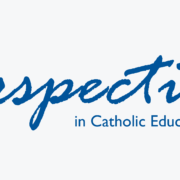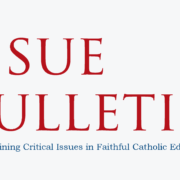Meeting Point Sex Ed Program Not Ready for Catholic Schools
The Meeting Point: Course of Affective Sexual Education for Young People (http://www.educazioneaffettiva.org/) is a high school-level sex education program developed by “a group of married couples in Spain,” supported by the Spanish Bishops’ Conference and released online by the Vatican’s Pontifical Council for the Family in July 2016. It is intended for use in Catholic high schools, parishes and homes.
Although The Cardinal Newman Society does not formally review educational materials, we have taken a close look at this program because of its high profile, parent concerns about its suitability for Catholic families, and our mission to promote and protect faithful Catholic education.
We find that The Meeting Point makes frequent use of sexually explicit and morally objectionable images, fails to clearly identify and explain Catholic doctrine from elemental sources including the Ten Commandments and the Catechism of the Catholic Church, and compromises the innocence and integrity of young people under the rightful care of their parents.
With admiration for the work of the Pontifical Council for the Family and confidence in the Church’s authority on faith and morals, we find that The Meeting Point in its present form represents a significant break from the traditional approach to Catholic instruction and learning about human sexuality.
Moreover, we note that no Vatican official has directed implementation of this program in Catholic homes, parishes or schools. Neither have the United States bishops proposed adoption of the program. It has only been presented online as a resource—and not even a final program but “an opportunity to convene a large community of people to collaborate, to work, to exchange experiences and knowledge in this special field of education.” It is hoped, then, that the program may be edited and substantially refined in response to the feedback that has been requested by the Pontifical Council.
For these reasons, and to protect the purity of young men and women and the integrity of faithful Catholic education in school and at home, The Cardinal Newman Society believes that—at the very least—substantial improvement of the program is required under the guidance of Catholic parents and experts in theology, catechesis, pedagogy and developmental psychology. Catholic parents and educators should not assume that this program in its current form is suitable for a faithful Catholic education simply because of its association with the Pontifical Council for the Family. Parents especially have the right and responsibility to ensure that their children are presented teaching that is both sound and appropriate.
Lack of Moral Foundations
Since its release, the program’s critics have noted that in its hundreds of pages of materials, little emphasis is placed on the Sixth and Ninth Commandments or on the sexual sins that pervade our culture—and how young people should respond to these threats. The program also is light on references to the Catechism of the Catholic Church, other Magisterial teachings and Sacred Scripture, especially with regard to moral law.
Instead, the “affective” program asks leading questions with minimal guidance, except what may be provided by the teacher or parent who leads the discussion. Without clear reference to the Church’s moral teachings, there is the danger that the student could succumb to relativism and false values.
For example, the Unit 2 lesson “Sex or Sexuality?” includes a group discussion (dividing girls and boys “if possible”) on what the words “sex” and “sexuality” suggest—casually noting that “boys can talk about hooking up, one-night stands, maybe making reference to their genital organs, etc., while the girls can talk more about maternity, pregnancy, falling in love…” The lesson makes no reference to the Church’s moral teaching, and the concepts of sin and chastity are not addressed until later in the program.
Contrast this with the warnings of the same Pontifical Council for the Family two decades ago in its 1995 document The Truth and Meaning of Human Sexuality: Guidelines for Education within the Family:
One widely-used, but possibly harmful, approach goes by the name of “values clarification”. Young people are encouraged to reflect upon, to clarify and to decide upon moral issues with the greatest degree of “autonomy”, ignoring the objective reality of the moral law in general and disregarding the formation of consciences on the specific Christian moral precepts, as affirmed by the Magisterium of the Church. Young people are given the idea that a moral code is something which they create themselves, as if man were the source and norm of morality. (Sec. 140)
While The Meeting Point does point to chastity and virtue, and therefore could not be described quite so harshly as “values clarification,” its affective approach and use of sexually explicit materials often leaves the student uncertain about moral expectations. The moral authority of the Church is too often hidden from view in The Meeting Point program, in part because it lacks clear and frequent references to the Church’s teaching.
The program also presses students into uncomfortable, inappropriate conversations about sex, which the Pontifical Council strongly opposed in The Truth and Meaning of Human Sexuality: “No one should ever be invited, let alone obliged, to act in any way that could objectively offend against modesty or which could subjectively offend against his or her own delicacy or sense of privacy (Sec. 127).”
This concern for modesty is repeated by Pope Francis in his apostolic exhortation Amoris Laetitia:
A sexual education that fosters a healthy sense of modesty has immense value… Modesty is a natural means whereby we defend our personal privacy and prevent ourselves from being turned into objects to be used. Without a sense of modesty, affection and sexuality can be reduced to an obsession with genitality and unhealthy behaviours that distort our capacity for love. (par. 282)
Morally Offensive Images
In order to spark frank discussion about sexuality among high school students, The Meeting Point incorporates sexually explicit images and discussions that are inappropriate, especially for Catholic schools.
The same “Sex or Sexuality?” lesson mentioned above, for example, has students evaluate a photograph that includes a bare-chested woman in an intimate embrace with a man. The stated “objective” is for students to feel “provoked” or even confused by the image. Several other sexually suggestive images are used in the same lesson.
The Unit 5 lesson titled “A Suitable Helper: Morality” contains three morally offensive advertisements that are to be viewed and discussed by students. One indicates a man’s attraction to pornography and adultery with the caption, “Part good. Part bad. That’s man’s essence.” An electronics ad features a partially naked man and woman in bed with the caption, “The second best thing to do in the dark.” The teacher’s notes acknowledge that “all three have a clearly erotic component.”
In the section on “Different Bodies,” teachers are instructed to have the students observe two photographs: “one of a newborn and the other of Antonio Lopez’s sculptures of a male and female body… to lead the youth to recognize sexual difference.” It is suggested that a biology teacher be present for this activity to help “review the identification of primary and secondary sex characteristics, observing the difference between male and female.” The students are then given a worksheet with a picture of the sculptures, followed by the question: “Can you identify the differences between them in a scientific way?”
It is natural and appropriate that older students should learn male and female anatomy at some point, but several images in The Meeting Point are obviously designed for sexual arousal or moral degradation. The authors may hope that students exercise perfect maturity and chastity in responding to the images, but that is an unrealistic expectation for most teenage boys and girls. American children are already bombarded with graphic sexual content; a Catholic educational program does not need to show them more.
Just two decades ago, these and other “abuses” in sex education were opposed by the Pontifical Council for the Family. The Truth and Meaning of Human Sexuality warned against schooling “whenever sex education is given to children by teaching them all the intimate details of genital relationships, even in a graphic way” (Sec. 139). It expected educators to be “positive and prudent” and “clear and delicate” in their presentation of “sexual information”:
No material of an erotic nature should be presented to children or young people of any age, individually or in a group.
This principle of decency must safeguard the virtue of Christian chastity. (Sec. 126)
The Sacred Congregation of Catholic Education, in its 1983 document Educational Guidance in Human Love: Outlines for Sex Education, advised great care in developing teaching materials for sex education, especially the choice of images. It recommended consultation with experts who can help ensure that teaching materials are psychologically, developmentally and morally appropriate.
It’s highly doubtful that The Meeting Point satisfies the Congregation’s expectations:
Some school text-books on sexuality, by reason of their naturalist character, are harmful to the child and the adolescent. Graphic and audio-visual materials are more harmful when they crudely present sexual realities for which the pupil is not prepared, and thus create traumatic impressions or raise an unhealthy curiosity which leads to evil. Let teachers think seriously of the grave harm that an irresponsible attitude in such delicate matters can cause in pupils. (Sec. 76)
Parents as Primary Educators
In his introduction to the program, Monsignor Carlos Simon Vazquez, undersecretary of the Pontifical Council for the Family, explains that The Meeting Point is not intended only for Catholic schools, but also for parish programs, Catholic associations and parents at home. Looking back on discussions about The Meeting Point at last year’s World Meeting of Families, Msgr. Simon attests that “we clearly saw the family’s primacy in the education of the children, and that emotional and sexual education is not something that exclusively or mainly pertains to the competence of institutions that are as necessary as schools are.”
Nevertheless, the adoption of any sex education program by schools or parish programs—unless with the direct and substantial involvement of parents—conflicts with the parents’ role as primary educators of their children, especially in matters of sexuality. Pope John Paul II, in his 1981 apostolic exhortation Familiaris Consortio, put sex education squarely under parents’ direction:
Sex education, which is a basic right and duty of parents, must always be carried out under their attentive guidance, whether at home or in educational centers chosen and controlled by them. In this regard, the Church reaffirms the law of subsidiarity, which the school is bound to observe when it cooperates in sex education, by entering into the same spirit that animates the parents. (Sec. 36-37)
Moreover, as the primary educators of their children, parents should not “tolerate immoral or inadequate formation being given to their children outside the home” (The Truth and Meaning of Human Sexuality, Sec. 44).
Clarification is needed on these points to ensure that schools and Church programs do not simply implement The Meeting Point under the impression that it is an “official” Catholic education program prescribed by the Vatican.
Not a Helpful Resource
There are other concerns about The Meeting Point program, such as the discussion of abortion in the Unit 5 lesson titled “I Am a Child; Right, Gift or Problem?” It makes no reference to abortion as a mortal sin; rather, unwanted pregnancies are discussed as a “problem” in society.
The lesson contains a troubling scenario to be read and discussed among students and teacher. In “the true story of a woman who was led by her circumstances and society to ‘eliminate her problem,’” an explicit description is rendered of a girl’s abortion experience that can be invasive for many young people. The discussion of the story ends with the instructor talking to students about lessening abortions by helping women with their “problems” in life, without also emphasizing the sacredness of all human life.
Especially in Unit 6, love is not clearly defined and can be confused with lust. The program resorts to qualitative descriptions like “beautiful love” and “true love,” which can mean virtually anything. It would be far better if the authors pointed students to C. S. Lewis or Dietrich von Hildebrand, 20th century authors who provide a clear understanding of this very misunderstood term.
It is because of the above concerns and others that The Meeting Point is not, in its current form, a helpful resource to Catholic families for forming students in Church teaching on sex and sexuality, and it needs significant revisions before serious consideration by Catholic parents, schools or parishes. We nevertheless look with hope to many fruitful efforts in the Church to respond to a hyper-sexualized culture that is often greatly at odds with Catholic morality and respect for the human person. The Cardinal Newman Society offers our own recently published resource for Catholic educators, Human Sexuality Policies for Catholic Schools, which recommends school policies that promote a faithful understanding of human sexuality, gender, marriage and chastity.
The Church brings to the modern world the guidance of the Holy Spirit and more than 2,000 years of reflection on the Gospel and on the human condition. Catholic youth deserve no less than to be taught these eternal truths.





